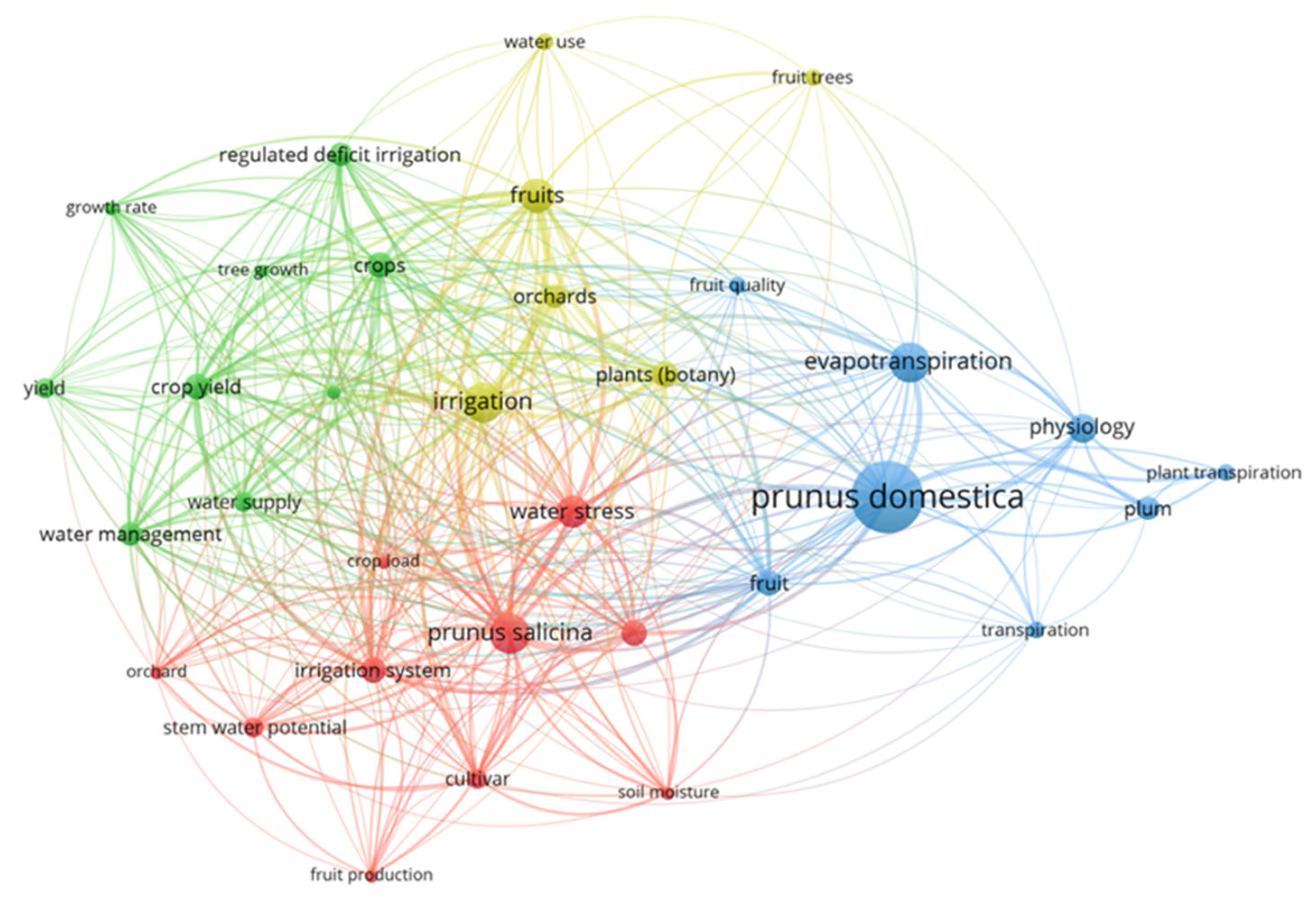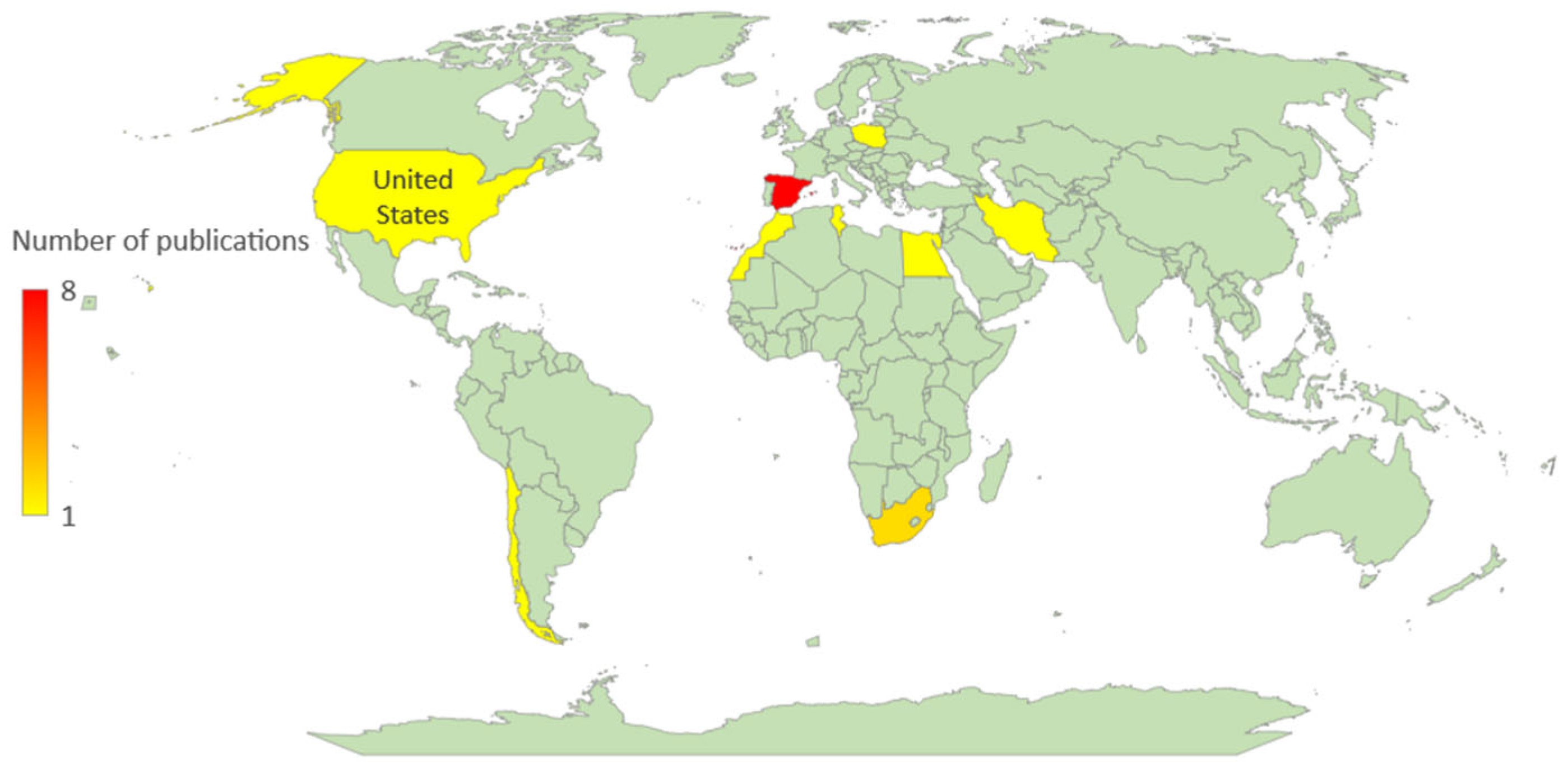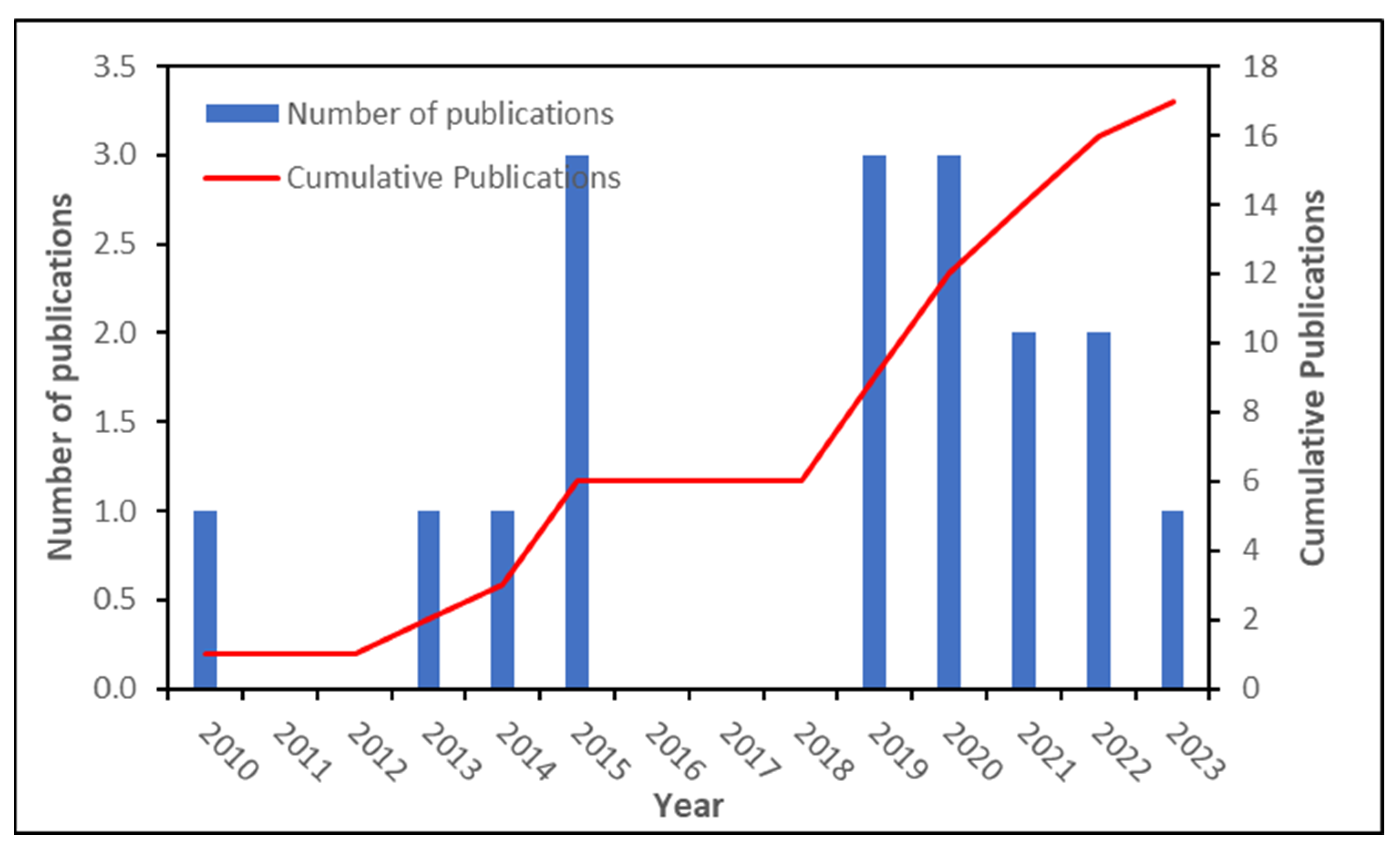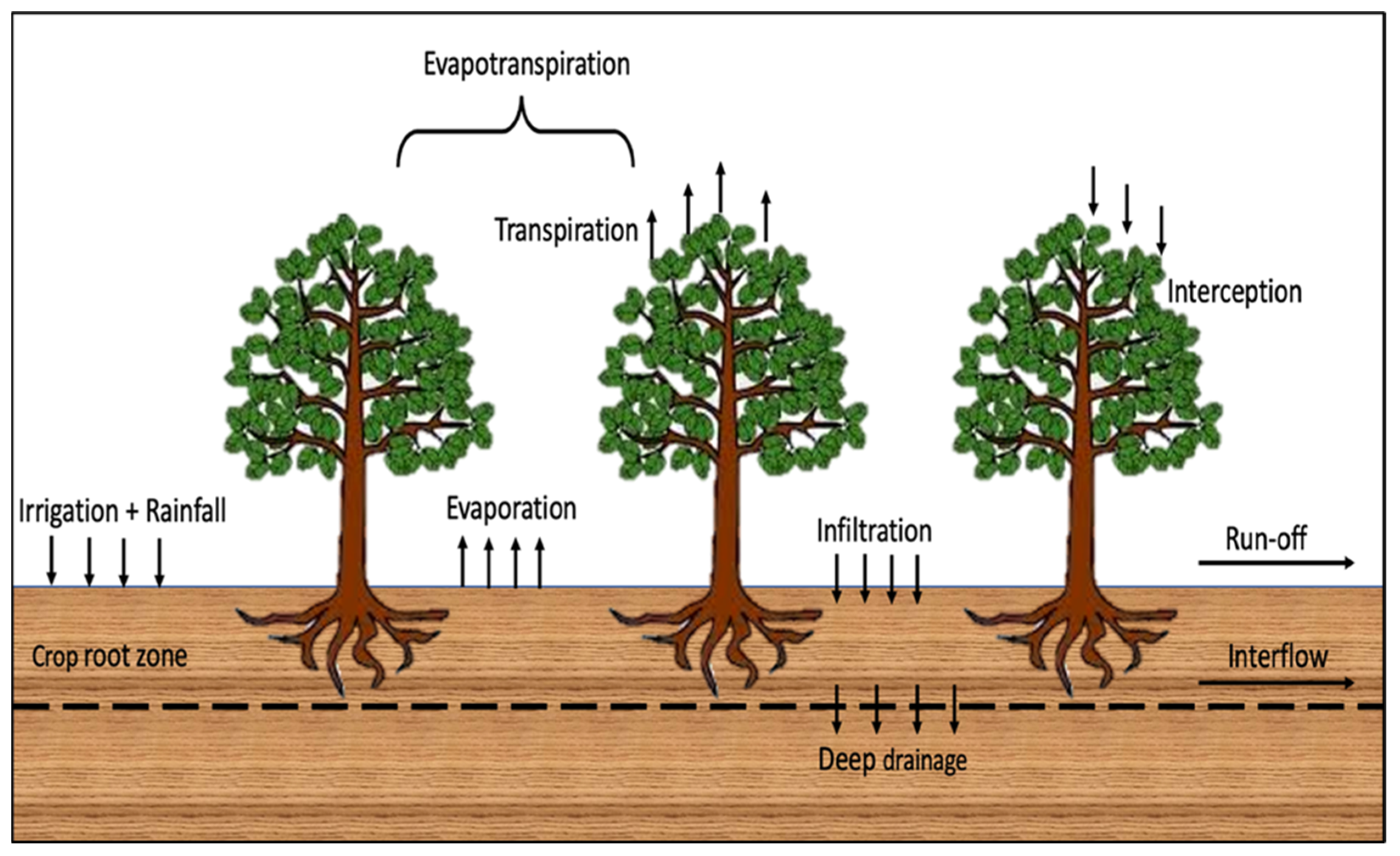Assessing the Seasonal Water Requirement of Fully Mature Japanese Plum Orchards: A Systematic Review
Abstract
:1. Introduction
2. Methodology
2.1. Scope, Literature Search and Inclusion and Exclusion Strategies
2.2. Data Extraction and Analysis
3. Results
3.1. Systematic Review
3.2. Evapotranspiration in Plum Orchards
3.3. Principles and Methods to Determine Evapotranspiration in Plum Orchards
3.4. Water Requirements of Japanese Plum Orchards
4. Study Limitations
5. Research Gaps
6. Conclusions
Author Contributions
Funding
Conflicts of Interest
References
- HortGro Key Deciduous Fruit Statistics. HortGro Technical Report. 2021. Available online: www.hortgro.co.za (accessed on 28 January 2022).
- Dzikiti, S.; Volschenk, T.; Midgley, S.J.E.; Lötze, E.; Taylor, N.J.; Gush, M.B.; Ntshidi, Z.; Zirebwa, S.F.; Doko, Q.; Schmeisser, M.; et al. Estimating the water requirements of high yielding and young apple orchards in the winter rainfall areas of South Africa using a dual source evapotranspiration model. Agric. Water Manag. 2018, 208, 152–162. [Google Scholar] [CrossRef]
- Naschitz, S.; Naor, A. The Effect of Crop Load on Tree Water Consumption of Golden Delicious’ Apples in Relation to Fruit Size: An Operative Model. J. Am. Soc. Hortic. Sci. 2005, 130, 7–11. [Google Scholar] [CrossRef]
- Fanadzo, M.; Ncube, B. Challenges and opportunities for revitalising smallholder irrigation schemes in South Africa. Water Sa 2018, 44, 436–447. [Google Scholar] [CrossRef]
- Pavel, E.W.; Vanassche, F.M.G.; Grossman, Y.L. Optimisation of irrigation management in mango trees by determination of water and carbon demands to improve water use efficiency and fruit quality. In Report to the Water Research Commission; WRC Report No.: 1136/1/03; WRC: Pretoria, South Africa, 2003. [Google Scholar]
- de Villiers, S.; de Wit, M. H2O-CO2-Energy Equations for South Africa: Present Status, Future Scenarios and Proposed Solutions Abstract. Aeon Rep Ser. 2010. Available online: https://www.researchgate.net/publication/258514523_H2O-CO2-energy_equations_for_South_Africa (accessed on 27 September 2023).
- Van Wilgen, B.W.; De Lange, W.J. The costs and benefits of biological control of invasive alien plants in South Africa. African Entomol. 2011, 19, 504–514. [Google Scholar] [CrossRef]
- Stevens, J.B. Adoption of Irrigation Scheduling Methods in South Africa. 2007, 461. Available online: https://repository.up.ac.za/handle/2263/24726 (accessed on 29 September 2023).
- Department of Agriculture, Forestry and Fisheries (DAFF). Plum Production Guidelines. Pretoria, South Africa. 2010. Available online: www.africanfarming.com/wp-content/uploads/Production-guidelines-for-plums-SA-Department-of-Agriculture-Forestry-and-Fisheries.pdf (accessed on 6 May 2022).
- Page, M.J.; Moher, D.; Bossuyt, P.M.; Boutron, I.; Hoffmann, T.C.; Mulrow, C.D.; Shamseer, L.; Tetzlaff, J.M.; Akl, E.A.; Brennan, S.E.; et al. PRISMA 2020 explanation and elaboration: Updated guidance and exemplars for reporting systematic reviews. BMJ 2021, 372, n160. [Google Scholar] [CrossRef] [PubMed]
- Horsley, T.; Dingwall, O.; Sampson, M. Checking reference lists to find additional studies for systematic reviews. Cochrane Database Syst. Rev. 2011, 2011, MR000026. [Google Scholar] [CrossRef]
- Van Eck, N.J.; Waltman, L.; Dekker, R.; Van Den Berg, J. A comparison of two techniques for bibliometric mapping: Multidimensional scaling and VOS. J. Am. Soc. Inf. Sci. Technol. 2010, 61, 2405–2416. [Google Scholar]
- Masenyama, A.; Mutanga, O.; Dube, T.; Bangira, T.; Sibanda, M.; Mabhaudhi, T. A systematic review on the use of remote sensing technologies in quantifying grasslands ecosystem services. GIScience Remote Sens. 2022, 59, 1000–1025. [Google Scholar] [CrossRef]
- Intrigliolo, D.S.; Castel, J.R. Response of plum trees to deficit irrigation under two crop levels: Tree growth, yield and fruit quality. Irrig. Sci. 2010, 28, 525–534. [Google Scholar] [CrossRef]
- Intrigliolo, D.S.; Ballester, C.; Castel, J.R. Carry-over effects of deficit irrigation applied over seven seasons in a developing Japanese plum orchard. Agric. Water Manag. 2013, 128, 13–18. [Google Scholar] [CrossRef]
- Intrigliolo, D.S.; Ballester, C.; Castel, J.R. Crop load regulation and irrigation strategies to accelerate the recovery of previously water-stressed Japanese plum trees. Agric. Water Manag. 2014, 132, 23–29. [Google Scholar] [CrossRef]
- Hamdani, A.; Hssaini, L.; Bouda, S.; Adiba, A.; Razouk, R. Japanese plums behavior under water stress: Impact on yield and biochemical traits. Heliyon 2022, 8, e09278. [Google Scholar] [CrossRef] [PubMed]
- Hajlaoui, H.; Maatallah, S.; Guizani, M.; Boughattas, N.E.H.; Guesmi, A.; Ennajeh, M.; Dabbou, S.; Lopez-Lauri, F. Effect of Regulated Deficit Irrigation on Agronomic Parameters of Three Plum Cultivars (Prunus salicina L.) under Semi-Arid Climate Conditions. Plants 2022, 11, 1545. [Google Scholar] [CrossRef] [PubMed]
- Samperio, A.; Moñino, M.J.; Vivas, A.; Blanco-Cipollone, F.; Martín, A.G.; Prieto, M.H. Effect of deficit irrigation during stage II and post-harvest on tree water status, vegetative growth, yield and economic assessment in “Angeleno” Japanese plum. Agric. Water Manag. 2015, 158, 69–81. [Google Scholar] [CrossRef]
- Blanco-Cipollone, F.; Moñino, M.J.; Vivas, A.; Samperio, A.; Prieto, M.H. Long-term effects of irrigation regime on fruit development pattern of the late-maturing ‘Angeleno’ Japanese plum. Eur. J. Agron. 2019, 105, 157–167. [Google Scholar] [CrossRef]
- Moñino, M.J.; Blanco-Cipollone, F.; Vivas, A.; Bodelón, O.G.; Prieto, M.H. Evaluation of different deficit irrigation strategies in the late-maturing Japanese plum cultivar “Angeleno” . Agric. Water Manag. 2020, 234, 106111. [Google Scholar] [CrossRef]
- Samperio, A.; Prieto, M.H.; Blanco-Cipollone, F.; Vivas, A.; Moñino, M.J. Effects of post-harvest deficit irrigation in “Red Beaut” Japanese plum: Tree water status, vegetative growth, fruit yield, quality and economic return. Agric. Water Manag. 2015, 150, 92–102. [Google Scholar] [CrossRef]
- Millán, S.; Casadesús, J.; Campillo, C.; Moñino, M.J.; Prieto, M.H. Using soil moisture sensors for automated irrigation scheduling in a plum crop. Water 2019, 11, 2061. [Google Scholar] [CrossRef]
- Jovanović, N.; Motsei, N.; Mashabatu, M.; Dube, T. Modelling Soil Water Redistribution in Irrigated Japanese Plum (Prunus salicina) Orchards in the Western Cape (South Africa). Horticulturae 2023, 9, 395. [Google Scholar] [CrossRef]
- Hajian, G.; Ghasemnezhad, M.; Fotouhi Ghazvini, R.; Khaledian, M.R. Effects of regulated deficit irrigation on vegetative growth, fruit yield and quality of japanese plum (Prunus salicina Lindell ’Methly’). Agric. Conspec. Sci. 2020, 85, 61–70. [Google Scholar]
- Hassan, I.F.; Gaballah, M.S.; El-Hoseiny, H.M.; El-Sharnouby, M.E.; Alam-Eldein, S.M. Deficit irrigation to enhance fruit quality of the ‘african rose’ plum under the egyptian semi-arid conditions. Agronomy 2021, 11, 1405. [Google Scholar] [CrossRef]
- Mushtaq, R.; Kumar, A.; Sharma, M.K. Achievements in Rootstock Breeding for Temperate Fruit Crops. In Advances in Horticultural Crops; Weser Books: Zittau, Gemany, 2018; Volume 59. [Google Scholar]
- Reig, G.; i Forcada, C.F.; Mestre, L.; Jiménez, S.; Betrán, J.A.; Moreno, M.Á. Horticultural, leaf mineral and fruit quality traits of two ‘Greengage’plum cultivars budded on plum based rootstocks in Mediterranean conditions. Sci. Hortic. 2018, 232, 84–91. [Google Scholar] [CrossRef]
- Melgarejo, P.; Calín-Sánchez, Á.; Hernández, F.; Szumny, A.; Martínez, J.J.; Legua, P.; Martínez, R.; Carbonell-Barrachina, Á.A. Chemical, functional and quality properties of Japanese plum (Prunus salicina Lindl.) as affected by mulching. Sci. Hortic. 2012, 134, 114–120. [Google Scholar] [CrossRef]
- Egea, J.A.; Caro, M.; García-Brunton, J.; Gambín, J.; Egea, J.; Ruiz, D. Agroclimatic Metrics for the Main Stone Fruit Producing Areas in Spain in Current and Future Climate Change Scenarios: Implications From an Adaptive Point of View. Front. Plant Sci. 2022, 13, 842628. [Google Scholar] [CrossRef] [PubMed]
- Annandale, J.G.; Stirzaker, R.J.; Singels, A.; van der Laan, M.; Laker, M.C. Irrigation scheduling research: South African experiences and future prospects. Water SA 2011, 37, 751–764. [Google Scholar] [CrossRef]
- Dodd, M.; Cronje, P.; Taylor, M.; Huysamer, M.; Kruger, F.; Lotz, E.; Merwe, K. van der A review of the post harvest handling of fruits in South Africa over the past twenty five years. S. Afr. J. Plant Soil 2010, 27, 97–116. [Google Scholar] [CrossRef]
- Vinukollu, R.K.; Wood, E.F.; Ferguson, C.R.; Fisher, J.B. Global estimates of evapotranspiration for climate studies using multi-sensor remote sensing data: Evaluation of three process-based approaches. Remote Sens. Environ. 2011, 115, 801–823. [Google Scholar] [CrossRef]
- Jovanovic, N.; Pereira, L.S.; Paredes, P.; Pôças, I.; Cantore, V.; Todorovic, M. A review of strategies, methods and technologies to reduce non-beneficial consumptive water use on farms considering the FAO56 methods. Agric. Water Manag. 2020, 239, 106267. [Google Scholar] [CrossRef]
- Wanniarachchi, S.; Sarukkalige, R. A Review on Evapotranspiration Estimation in Agricultural Water Management: Past, Present, and Future. Hydrology 2022, 9, 123. [Google Scholar] [CrossRef]
- Allen, R.G.; Pereira, L.S.; Raes, D.; Smith, M. Crop Evapotranspiration; FAO Irrigation and Drainage Paper 56; Food and Agriculture Organization (FAO): Rome, Italy, 1998. [Google Scholar]
- Costa, J.M.; Monnet, F.; Jannaud, D.; Leonhardt, N.; Ksas, B.; Reiter, I.M.; Pantin, F.; Genty, B. Open all night long: The dark side of stomatal control. Plant Physiol. 2015, 167, 289–294. [Google Scholar] [CrossRef]
- Jovanovic, N.; Dzikiti, S.; Gush, M. An Integrated Approach for the Estimation of Crop Water Requirements Based on Soil, Plant and Atmospheric Measurements; Burleigh Dodds Science Publishing: Cambridge, UK, 2018; pp. 91–128. [Google Scholar] [CrossRef]
- Jones, H.G.; Lakso, A.N.; Syvertsen, J.P. Physiological Control of Water Status in Temperate and Subtropical Fruit Trees; CABI Digital Library: Kent, UK, 1985; pp. 301–344. [Google Scholar]
- Doko, Q. Quantifying the Water Use of Apple Orchards. Master’s Thesis, University of Pretoria, Pretoria, South Africa, 2017. [Google Scholar]
- Turner, N.C. Plant water relations and irrigation management. Agric. water Manag. 1990, 17, 59–73. [Google Scholar] [CrossRef]
- Sack, L.; Scoffoni, C. Measurement of leaf hydraulic conductance and stomatal conductance and their responses to irradiance and dehydration using the Evaporative Flux Method (EFM). JoVE 2012, e4179. [Google Scholar] [CrossRef] [PubMed]
- Ntshidi, Z.; Dzikiti, S.; Mazvimavi, D.; Mobe, N.T. Contribution of understorey vegetation to evapotranspiration partitioning in apple orchards under Mediterranean climatic conditions in South Africa. Agric. Water Manag. 2021, 245, 106627. [Google Scholar] [CrossRef]
- Willaume, M.; Lauri, P.-É.; Sinoquet, H. Light interception in apple trees influenced by canopy architecture manipulation. Trees 2004, 18, 705–713. [Google Scholar] [CrossRef]
- Chootummatat, V.; Turner, D.W.; Cripps, J.E.L. Water use of plum trees (Prunus salicina) trained to four canopy arrangements. Sci. Hortic. 1990, 43, 255–271. [Google Scholar] [CrossRef]
- Gush, M.B.; Taylor, N.J. The Water Use of Selected Fruit Tree Orchards (Volume 2): Technical Report on Measurements and Modelling; Water Research Commission Report WRC Report no. 1770/2/14; WRC: Pretoria, South Africa, 2014; Volume 2, pp. 1–146. [Google Scholar]
- Shoko, C. The Effect of Spatial Resolution in Remote Sensing Estimates of Total Evaporation in the uMgeni Catchment. Ph.D. Thesis, University of Kwazulu-Natal, Pietermaritzburg, South Africa, 2014. [Google Scholar]
- Lott, R.B.; Hunt, R.J. Estimating evapotranspiration in natural and constructed wetlands. Wetlands 2001, 21, 614–628. [Google Scholar] [CrossRef]
- Gibson, L.A.; Jarmain, C.; Su, Z.; Eckardt, F.E. Estimating evapotranspiration using remote sensing and the surface energy balance system—A South African perspective. Water SA 2013, 39, 477–484. [Google Scholar] [CrossRef]
- Mashabatu, M.; Ntshidi, Z.; Dzikiti, S.; Jovanovic, N.; Dube, T.; Taylor, N.J. Deriving crop coefficients for evergreen and deciduous fruit orchards in South Africa using the fraction of vegetation cover and tree height data. Agric. Water Manag. 2023, 286, 108389. [Google Scholar] [CrossRef]
- Stachowski, P.; Jagosz, B.; Rolbiecki, S.; Rolbiecki, R. Predictive capacity of rainfall data to estimate the water needs of fruit plants in water deficit areas. Atmosphere 2021, 12, 550. [Google Scholar] [CrossRef]
- Dzikiti, S.; Schachtschneider, K. Technical Report: Water Stewardship for Stone Fruit Farmers; WWF Technical Report. South Africa. 2015. Available online: www.wwf.org.za/freshwater (accessed on 3 October 2023).
- Doorenbos, J. Crop water requirements. FAO Irrig. Drain. Pap. 1977, 24, 1–144. [Google Scholar]
- Fereres, E.; Aldrich, T.; Schulbach, H.; Martinich, D. Responses of young almond trees to late-season drought. Calif. Agric. 1981, 35, 11–12. [Google Scholar]
- Razouk, R.; Kajji, A.; Hamdani, A.; Charafi, J.; Hssaini, L.; Bouda, S. Yield and fruit quality of almond, peach and plum under regulated deficit irrigation. Front. Agric. Sci. Eng 2020, 7, 325. [Google Scholar] [CrossRef]
- Casadesús, J.; Mata, M.; Marsal, J.; Girona, J. A general algorithm for automated scheduling of drip irrigation in tree crops. Comput. Electron. Agric. 2012, 83, 11–20. [Google Scholar] [CrossRef]
- Mhawej, M.; Faour, G. Open-source Google Earth Engine 30-m evapotranspiration rates retrieval: The SEBALIGEE system. Environ. Model. Softw. 2020, 133, 104845. [Google Scholar] [CrossRef]
- Gavilán, V.; Lillo-Saavedra, M.; Holzapfel, E.; Rivera, D.; García-Pedrero, A. Seasonal crop water balance using harmonized Landsat-8 and Sentinel-2 time series data. Water 2019, 11, 2236. [Google Scholar] [CrossRef]
- Nagler, P.L.; Cleverly, J.; Glenn, E.; Lampkin, D.; Huete, A.; Wan, Z. Predicting riparian evapotranspiration from MODIS vegetation indices and meteorological data. Remote Sens. Environ. 2005, 94, 17–30. [Google Scholar] [CrossRef]
- Glenn, E.P.; Huete, A.R.; Nagler, P.L.; Nelson, S.G. Relationship between remotely-sensed vegetation indices, canopy attributes and plant physiological processes: What vegetation indices can and cannot tell us about the landscape. Sensors 2008, 8, 2136–2160. [Google Scholar] [CrossRef]
- Mashabatu, M. Determining Crop Coefficients for Irrigated Fruit Tree Crops Using Readily Available Data Sources. Master’s Thesis, University of the Western Cape, Bellville, South Africa, 2022. [Google Scholar]
- Torrecillas, A.; Corell, M.; Galindo, A.; Pérez-López, D.; Memmi, H.; Rodríguez, P.; Cruz, Z.N.; Centeno, A.; Intrigliolo, D.S.; Moriana, A. Agronomical effects of deficit irrigation in apricot, peach, and plum trees. In Water Scarcity and Sustainable Agriculture in Semiarid Environment; Elsevier: Amsterdam, The Netherlands, 2018; pp. 87–109. [Google Scholar]
- Naor, A. Irrigation scheduling and evaluation of tree water status in deciduous orchards. Hortic. Rev. 2006, 32, 111–165. [Google Scholar]






| Reference | Location | Method | Cultivar | Water Use (mm a−1) | Water Use (mm season−1) | Key Findings |
|---|---|---|---|---|---|---|
| [24] | South Africa | HYDRUS-2D | Fortune, African Delight | 858–864 (Septemebr–March) 534–641 (September–January) | Initial basal crop coefficients varied from 0.98 to 1.01, whilst basal crop coefficients for the mid-stage averaged between 1.11 (cv. African Delight) and 1.18 (cv. Fortune). | |
| [17] | Morocco | FAO-56 Kc | Santa Rosa, Timhdit, Red Beaut, Black Amber, Black Diamond, Black Gold, Obilnaja, Fortune, Black Star | The cultivars’ yield and fruit weight significantly decreased from the first year of deficit irrigation application. The cv. Fortune was the most insensitive to drought, whereas the cv. Black Diamond and the cv. Timhdit showed the lowest drought tolerability. | ||
| [18] | Tunisia | FAO-56 Kc | Black Diamond, Black Gold and Black Star | The three cultivars had tolerance to moderate stress with varying response times to drought stress. | ||
| [51] | Poland | Press, Grabarczyk and Rzekanowski and Treder | 455–718 | Regardless of the method used, the rainfall volumes received in the studied period did not cover the water requirements of the fruit trees. The Treder method seemed to be the simplest and most accessible method. | ||
| [26] | Egypt | FAO-56 Kc | African Rose | Deficit irrigation could be a sustainable novel solution to improve the fruit quality of the cv. African Rose grown under semi-arid conditions. | ||
| [21] | Spain | SWB | Angeleno | 1011–1187 | Deficit irrigation treatments were found to be effective at controlling tree vigor, with a lower trunk cross-sectional area growth and pruned wood weight. | |
| [25] | Iran | CROPWAT | Methly | Moderate water stress (75% RDI) improved fruit yield and saved water without an undesirable effect on plum fruit quality. | ||
| [23] | Spain | Soil Moisture Sensors, IRRIX | Red Beaut | After two years of testing, the automated system could “simulate” the irrigation scheduling programmed by a human expert without human intervention. | ||
| [20] | Spain | FAO-56 Kc | Angeleno | After eight years of applying the RDI strategies, no carry-over effects on the orchard yield were observed. Based on these results, RDI appears to be a sustainable practice for the cv. Angeleno and the growing conditions. | ||
| [22] | Spain | FAO-56 Kc | Red Beaut | 835–1159 | The RDI treatments were suitable for reducing the total pruning weight. In the long term (five seasons), the effect of post-harvest RDI had no negative cumulative impact on tree productivity. | |
| [19] | Spain | FAO-56 Kc | Angeleno | 962–1211 | This study suggests that allowing some degree of water stress during stage II and post-harvest appears to offer an effective management strategy for saving water and controlling vegetative growth without negatively affecting crop yield or farmers’ economic return. | |
| [16] | Spain | FAO-56 Kc | Black Gold | Crop load regulation is a valuable tool allowing plum trees to quickly recover from the detrimental effects of long-term deficit irrigation. | ||
| [15] | Spain | FAO-56 Kc | Black Gold | Deficit irrigation strategies should be used with caution in developing orchards. Only slight restrictions can be imposed to avoid the long-term carry-over effects of deficit irrigation on tree performance. | ||
| [14] | Spain | FAO-56 Kc | Black Gold | 432–525 (April–October) | The RDI strategy allowed for 30% water savings, increasing the tree water use efficiency with minimal effect on crop yield and fruit growth, providing that the plant water stress during the fruit growth period was low (stem water potential > −1.5 MPa). | |
| [57] | USA | SEBALI | 994 | The proposed open-source system aims to improve the assessment of ET and water productivity and the management of water resources. | ||
| [58] | Chile | NDVI time series | 331 (December–March) | It is possible to estimate evapotranspiration using a Normalized Difference Vegetation Index (NDVI) time series by integrating data from Landsat 8 and Sentinel-2 sensors, improving irrigation water management at the plot and water distribution system scales. | ||
| [52] | South Africa | EC | African Delight | 921 | Accurate estimation of crop water requirements attracts potential water savings of up to 20% in certain situations. These results apply at a very localized level. Western Cape farmers, compared to those internationally, show that they are two to nine times more efficient in their water use during fruit production than the international water footprint averages suggest. |
Disclaimer/Publisher’s Note: The statements, opinions and data contained in all publications are solely those of the individual author(s) and contributor(s) and not of MDPI and/or the editor(s). MDPI and/or the editor(s) disclaim responsibility for any injury to people or property resulting from any ideas, methods, instructions or products referred to in the content. |
© 2024 by the authors. Licensee MDPI, Basel, Switzerland. This article is an open access article distributed under the terms and conditions of the Creative Commons Attribution (CC BY) license (https://creativecommons.org/licenses/by/4.0/).
Share and Cite
Mashabatu, M.; Motsei, N.; Jovanović, N.; Dube, T.; Mathews, U.; Nqumkana, Y. Assessing the Seasonal Water Requirement of Fully Mature Japanese Plum Orchards: A Systematic Review. Appl. Sci. 2024, 14, 4097. https://doi.org/10.3390/app14104097
Mashabatu M, Motsei N, Jovanović N, Dube T, Mathews U, Nqumkana Y. Assessing the Seasonal Water Requirement of Fully Mature Japanese Plum Orchards: A Systematic Review. Applied Sciences. 2024; 14(10):4097. https://doi.org/10.3390/app14104097
Chicago/Turabian StyleMashabatu, Munashe, Nonofo Motsei, Nebojša Jovanović, Timothy Dube, Ubaidullah Mathews, and Yolanda Nqumkana. 2024. "Assessing the Seasonal Water Requirement of Fully Mature Japanese Plum Orchards: A Systematic Review" Applied Sciences 14, no. 10: 4097. https://doi.org/10.3390/app14104097
APA StyleMashabatu, M., Motsei, N., Jovanović, N., Dube, T., Mathews, U., & Nqumkana, Y. (2024). Assessing the Seasonal Water Requirement of Fully Mature Japanese Plum Orchards: A Systematic Review. Applied Sciences, 14(10), 4097. https://doi.org/10.3390/app14104097








